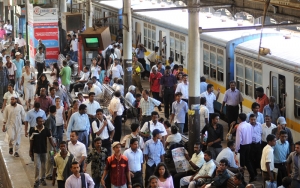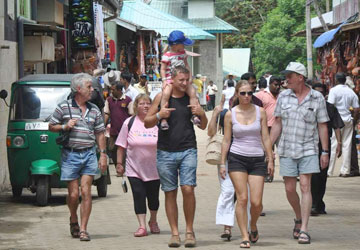
Wednesday 25th June 2014

Lakshman I.Keerthisinghe LLB, LLM.MPhil,Attorney-at-Law
"We met some wonderful people, learned how to head-bobble, ate rice and curry with our hands in dingy dives, held cobras, hugged elephants, played with monkeys, explored ancient forest monasteries, taught ourselves some Sinhala, read up on legends and then visited the very places they played out. We ventured into mosques, temples and kovils, chewed betel, drank coconuts and played cricket. And that’s just a fraction of our Ceylonese adventures! "
- Jurgen Horn and Michael Powell - 91 Days in Sri Lanka
In the twelfth century, the explorer Marco Polo wrote that Sri Lanka was the finest island in the whole world. For centuries it had been a tourism destination, particularly for European travellers. The Sri Lankan ethnic conflict that spanned nearly three decades and ended in 2009 has had a negative impact on tourism and the growth of the industry stagnated, however following this era a resurgence in Sri Lanka as a tourist destination has been evident. In 2012, post office worldwide holiday costs barometer named Sri Lanka as the best valued destination for holidays.
The advantage of Sri Lanka as a tourism destination is threefold. Firstly it is an authentic tourism destination. Secondly it is a compact island of 65,610 sq.km where a tourist can travel the length and breadth of the country within a few days, thirdly the diversity of the tourism product is unparalleled. For the simplicity of communicating the diversity of Sri Lanka in 2010 the tourism authorities started positioning the country around eight different products namely; beaches, heritage, wildlife, scenic beauty, mind and body wellness, festivals, sports and adventure and Essence. The Essence of Sri Lanka include what is unique to the country such as its people, art and culture, spices, tea, gems, handy crafts etc.
Being an island Sri Lanka is surrounded by sea and a perfect destination for a beach holiday. When the seas are rough on one side of the island there is calm waters on the other side. So it is a year round beach destinations. Such destination in the West Coast are in Negambo (35 km north of Colombo), Mount Lavinia(12 km south of Colombo) and Kalutara (42 km south of Colombo).
Heritage sites
In the South Coast such beaches are in Bentota (62 km south of Colombo), Ambalangoda (Approx 85 km south of Colombo), Hikkaduwa (98 km south of Colombo), Roomassala (119 km south of Colombo), Unawatuna (120 km south-east of Colombo), Weligama (143 km south-east of Colombo), Mirissa (151 km South east from Colombo), Matara (160 km south of Colombo) and Tangalle (195 km south-east of Colombo) while on the East Coast they are in Arugam Bay (315 km east of Colombo) and Pasikudah (Batticaloa). The Northern Coastal area has such beaches in Nilaveli and Uppuveli (280 km north-east of Colombo) and also in Trincomalee (257 km north-east of Colombo)
With a recorded history of more than 2500 years Sri Lanka has a rich heritage. There are eight world heritage sites within the country which include; The hill capital Kandy where the Temple of the Sacred Tooth Relic is located, the sacred city of Anuradhapura, the Dutch fort of Galle, the ancient city of Polonnaruva, the rock fortress of Sigiriya, the golden rock temple of Dambulla, the beautiful Horton plains and the Singharaja rain forest.
Apart from these famous sites there are hundreds of heritage sites in the island which are frequented by tourists. Maligawila is an ancient Monastery with the largest statue of the Buddha in Sri Lanka while Yapahuwa – is an ancient Fortress with salubriuos Nuwara Eliya up in the hills with a cool climate where Seetha Amman Temple and Gayathri Kovil are located.

For a small island the biodiversity of the country is most impressive. Sri Lanka is home for a wide variety of mammals, birds, fish, butterflies and snakes.
The big five Sri Lankan wildlife are the elephant, the leopard, the sloth bear, the blue whale and the sperm whale. Some of the wildlife parks in Sri Lanka are:Yala National Park - most visited, and second-largest in Sri Lanka. Udawalawe National Park - famous for elephant watching, Kumana National Park - famous for bird watching, Bundala National Park - famous for bird watching, Wasgamuwa National Park - one of the most attractive national parks, Wilpattu National Park - largest in Sri Lanka, famous for leopards, Minneriya National Park - famous for elephants, Horton Plains National Park - only national park in hill country and famous for sambar, Mullaitive National Park - proposed for elephant watching. Tourists who like to watch elephants also visit Pinnawala Elephant Orphanage and Udawalawe Elephant Transit Centre.
Due to varying climate conditions and geography Sri Lanka is an ideal destination for sports tourism. Some of the popular sports include golf, surfing, diving and snorkeling, hot air ballooning, rafting and canoeing, scuba diving, fishing, cycling, hiking, trekking and rock climbing. Locations popular for specific sports are:White water rafting at Kitulgala, surfing at Arugam Bay, boating at Bentota Bolgoda, Madhu ganga, and Koggala, trekking at Knuckles mountain range, Hortan plains, Sripada aka Adam's peak.
Sri Lanka is famous for traditional Ayurveda hospitals and spas, yoga training and a large number of meditation centres. Waterfall of Sri Lanka are: Bambarakanda Falls, Dunhinda Falls, Ramboda Falls, Devon Fall, St. Clair's Falls, Laxapana Falls, Baker's Falls Ravana Falls and Diyaluma Falls. Botanical Gardens of Sri Lanka are Royal Botanical Gardens in Peradeniya and Hakgala Botanical Gardens. For a country where people practice four main religions Sri Lanka has always maintained religious harmony among communities. With Buddhism, Islam, Hinduism and Christianity playing imports roles of lives of people Sri Lanka has religious or cultural festivals throughout the year. Famous festivals of Sri Lanka Duruthu Perahera, Thai Pongal, Aluth Sahal Mangallaya, Milad un-Nabi, Independence Day Celebrations, Navam Perahera, Maha Shivratri, Sinhala and Tamil New Year Celebrations, Easter Celebrations, Galle Literary Festival, Vesak Festival, Poson Festival, Esala Perehara, Katharagama Festival, Vel Festival, Hikkaduwa Beach Festival, Ramadan festival, Colombo Art Biennale, Lanka Design Festival, Christmas and the Electric Peacock Festival.
Biggest tea producing country
The precious stones such as rubies and sapphires frequently found in Ratnapura and 90 per cent of the rocks of the island are of Precambrian age, 560 million to 2,400 million years ago.
The gems form in sedimentary residual gem deposits, eluvial deposits, metamorphic deposits, skarn and calcium-rich rocks. Other gems are of magmatic origin. Some of the most notable precious stones are: Blue Sapphires, Star Sapphires, Rubies, Pink Sapphires, Orange Sapphires, Padparadschas, Cats Eyes, Alexandrite, Chrysoberyls, Garnets, Spinets, Moonstones, Aquamarines and Topazes. Spices of Sri Lanka include Cinnamon (kurundu), Cloves (karabunati), Cardamom (karadamungu), Black pepper (gammiris), Gambog (goraka), Turmeric (kaha), Curry leaf (karapincha), Mustard (abba),Coriander (kottamalli), Lemon grass (sera), Nutmeg (sadikka), Cumin (suduru), Sweet cumin (maduru), Fenugreek (Uluhal), Dill seeds (Asamodagam), Red dry chillies (viyalimiris) and Mace (wasawasi).
Sri Lanka is the third biggest tea producing country in the world. The country is best known in the world market for the production of unorthodox tea. Tea was introduced to the country by the British who called the country “Ceylon”. Pure “Ceylon Tea” is considered some of the finest tea produced anywhere in the world.
There are three main traditional dance forms in Sri Lanka: Kandyan Dancing, Low Country Dancing and Sabaragamuwa Dancing. Though not unique to Sri Lanka 'Bharatanatyam' which originated from India is also popular in Sri Lanka particularly among the Tamil community.
Different types of handicrafts are available in Sri Lanka: Wood carving, silver wear, brass castings, ceramic ware, bamboo products, pottery, batiks, lace works, cane works, costume jewellery, lacquerware, wooden masks, coir goods, handlooms and ivory products.
Sri Lankan people are generally known for their hospitality. Most tourists admire the genuine smile of the people according to airport exit surveys. Major hotel development projects are currently underway in Sri Lanka. Sri Lanka already has a well developed hotel chain throughout the island. Tourism in Sri Lanka, despite its benefits for the local economy (it is one of the main foreign income sources of the country), is undergoing several critics.
Thus, some studies indicate that a quick modern tourism development would not cater to the specific needs of the local people. Also, the high biodiversity of Sri Lanka seems to be threatened by the development of mass tourism which has already affected several natural reserves. Some endangered animal species seem to be seriously threatened by the rise of tourism in some area. An alternative kind of tourism – called Eco-tourism, sustainable tourism or responsible tourism - enables travellers to do tourism throughout Sri Lanka while contributing on the well-being of the local communities and making sure the environmental impact is limited. The Sri Lanka Eco-tourism Foundation is the national organization that created an official eco-tourism network through the island, allowing to develop sustainable tourism with wide options of travel. In 2010, the foundation won the presidential awards for "Outstanding Contribution for Tourism in Sri Lanka".
It is noteworthy that Tourism is a vital area in the Mahinda Chinthana policy framework. It has been identified as capable of effectively driving the country’s socio-economic development. The program’s vision for the tourism sector is to make Sri Lanka the foremost leisure destination in the South Asian Region.
Foreign exchange
The program believes the human resources and natural and cultural endowments, values and ethos will be fundamental in transforming Sri Lanka into a ce ntre of excellence and offer tourists, the highest values of authentic experiences in its unique setting. Its key objectives include the achievement of 2.0 million tourist arrivals by the year 2016, targeting the upscale Free Independent Travellers (FITS), who are comparatively high spenders making tourism Sri Lanka’s third largest foreign exchange earner and transforming tourism to become the fastest job creator and help reduce the unemployment levels.
The Government of Sri Lanka is committed to ensuring a controlled and planned development of tourism is carried out. High priority will be given towards sustainable tourism development, which involves cleaner, wholesome production, protection of indigenous flora and fauna as well as archaeological and cultural treasures.
The program hopes to move the industry from mass tourism to concentrated marketing, particularly on high income earners. In order to promote upscale tourism, market segmentation and diversification will be carried out. The diversified segments would include nature tourism, adventure tourism, agri-tourism, culture tourism, community tourism, sports tourism, eco-tourism, and wellness tourism. The targeted markets include Japan, China, Korea and Australia. In conclusion, it is discerned that Sri Lanka is now well on the threshold of an era where a boom in the tourist industry thereby raking in valuable foreign exchange to our motherland is imminent.
From : http://www.dailynews.lk/?q=features/smorgasbord-tourist-attractions




